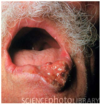Premalignant & Malignant Lesions Flashcards
Premalignant (potentially malignant) lesions
Benign, morphologically-altered tissue with greater than normal risk of malignant transformation
Malignant transformation potential
Risk of cancer being present in a premalignant lesions, at initial diagnosis or the future
Cervical intraepithelial neoplasia
Premalignant lesion of the uterus, which shows 20% malignant transformation potential
conclusion
cancer is often preceded by premalignant lesions
careful examination needed for diagnosis
oral cancer mortality have remained steady
dentists have a critical role in improving rates

Leukoplakia
White patch that cannot be clinically or pathologically diagnosed as any other condition
Represents 85% of all premalignant lesions
33% of cancers have leukoplakia around
80% of patients are smokers, smokers > non-smokers, heavy > light, may resolve after cessation
more common in males >40 years, average age of pt is 60
70% occur in lip vermillion, buccal mucosa and gingiva. Those in tongue and floor of mouth more likely to be dysplastic/malignant
starts in gingiva, progressive growth, eventually transforms in cancer

Proliferative verrucous leukoplakia
Red patch that cannot be clinically or pathologically diagnosed as any other condition
Same risk factors as oral cancer
Less common than leukoplakiam but greater malignant potential
Erythroplakia

Erythroplakia
well-demarcated macule/plaque, with velvety texture

Erythroplakia
Common in floor of mouth, tongue and palate (soft)

Erythroleukoplakia
association of erythroplakia and leukoplakia
90% show severe dysplasia, carcinoma in situ or invasive cancer on biopsy
Types of smokeless tobacco (aka “spit tobacco”)
chewing tobacco (loose leaf), moist snuff (dipping), dry snuff
smokeless tobacco keratosis

Moist snuff
usually place in the vestibule

smokeless tobacco keratosis
caries, gingival recession and halitosis

smokeless tobacco keratosis
lesions can become thicker and appear leathery or nodular
seen mostly in indian subcontinent, southeast Asia, Taiwan, South China and New Guinea
Associated w/ use of betel quid or paan
Wrap or areca tree nut and lime, usually with tobacco
trismus is usually chied complaint
Oral submucous fibrosis

Oral submucous fibrosis
Betel chewer’s mucosa: brown/red incrustations (not precancerous)

Oral submucous fibrosis
pallor and fibrosis of the soft palate (“marble-like pallor”)
long-term exposure to UV, fair skin, tendency to sun burn, 10x more in males, patients >45 yo
slow development, atrophy of vermillion borer, smooth surface and paleness, blurring of vermillion margin
rough, scaly areas develop, leukoplakia areas appear, scaly material, multifocal ulcers develop
6% malignant transformation potential

Actinic cheilitis
80% of pts are smokers, 8x increased risk, risk of secondary carcinomas, 30% of pts are drinkers, 20% have cirrhosis, 15x risk (+ cigarette)
Squamous cell carcinoma
due to UV damage
70% pts outdoor occupation
90% lower lip
metastases are rare

squamous cell carcinoma of the lip


